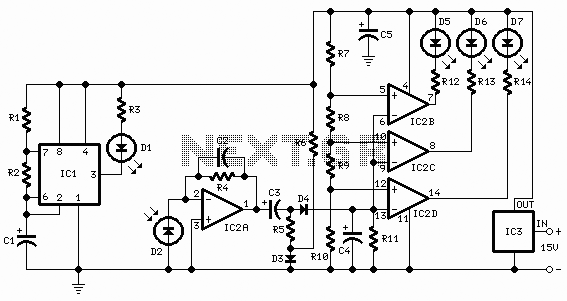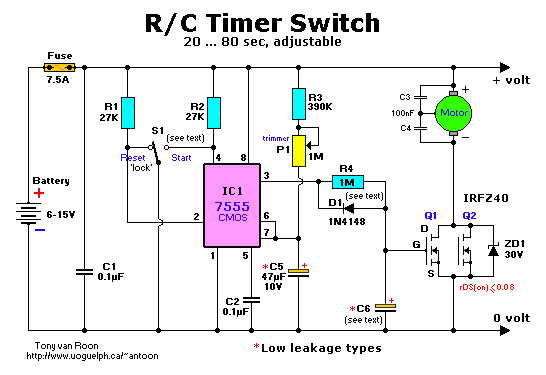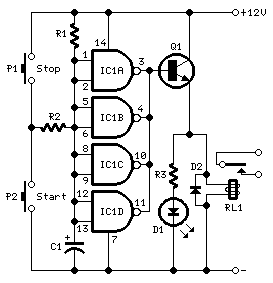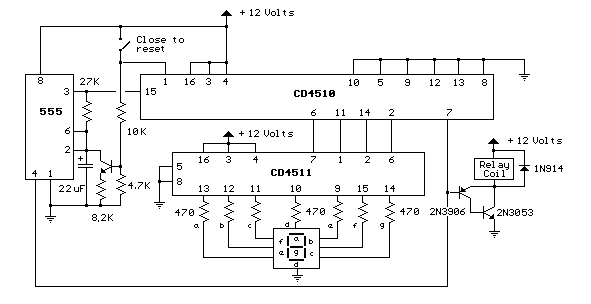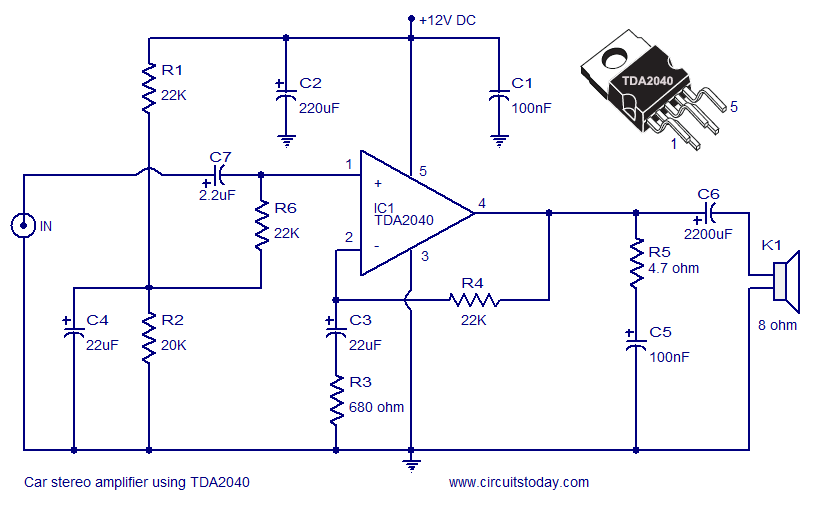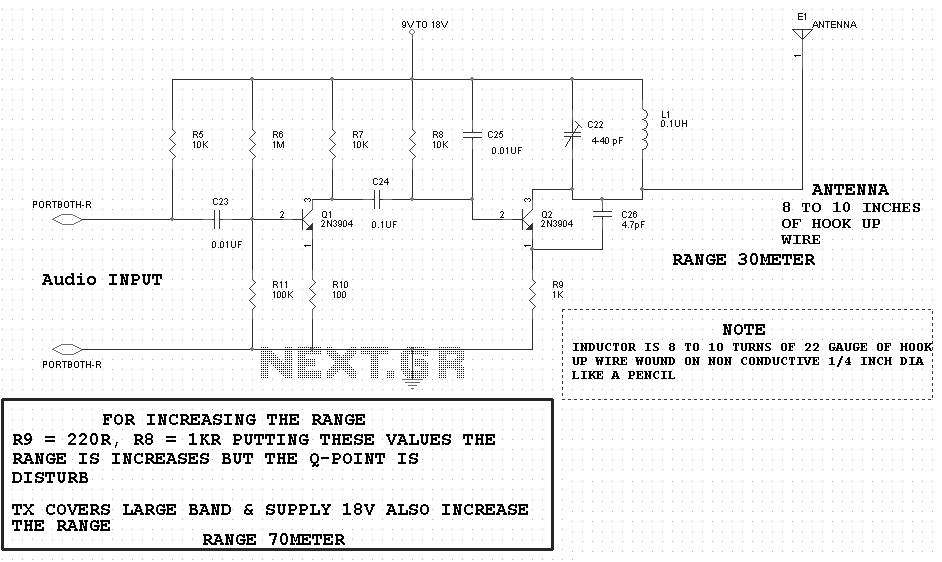
car headlights timer schematics
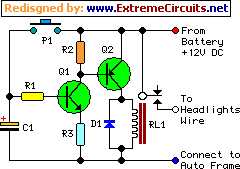
This device functions as a simple timer that keeps the vehicle's headlights on for approximately 1 minute and 30 seconds, allowing access to dark areas without the need to return and switch off the lights. Pressing switch P1 enables capacitor C1 to charge from the full 12V battery supply. Consequently, transistor Q1 is activated, which in turn drives transistor Q2 and its associated relay load. The headlights are activated through the relay contact connected in parallel with the vehicle's headlight switch. Relay RL1 remains engaged until capacitor C1 is nearly fully discharged, which occurs when its voltage drops below approximately 0.7V. The timing delay of the circuit is determined by the values of C1 and resistor R1, and is set to about 1 minute and 30 seconds. Due to the wide tolerance of electrolytic capacitors, this delay can vary between approximately 1 minute and 30 seconds to 1 minute and 50 seconds. An interesting variation involves using the interior lamp as a command source for the timer. In this scenario, when the door is opened, C1 charges, but it begins to discharge only when the door is closed, replacing the pushbutton operation. To configure the circuit in this manner, the cathode of a 1N4002 diode should be connected to the R1-C1 junction, and the anode should be connected to the "live" lead of the interior lamp. This lead can be identified using a voltmeter, as it is the one where a 12V voltage can be measured relative to the vehicle frame when the lamp is illuminated.
The schematic for this timer circuit can be designed utilizing standard electronic components. The core components include a 12V battery, a capacitor (C1), resistors (R1), transistors (Q1 and Q2), a relay (RL1), and a diode (1N4002).
The circuit operates as follows: When the user presses switch P1, capacitor C1 begins to charge through resistor R1. The charging time is dictated by the RC time constant, which is determined by the values of R1 and C1. Once C1 reaches a sufficient voltage, around 0.7V, it activates Q1, turning it on. This action allows current to flow to Q2, which energizes the relay RL1, closing its contacts and powering the vehicle's headlights.
The headlights remain lit as long as the relay is activated. The discharge of C1 occurs through R1 and the load of the circuit, which includes the base-emitter junction of Q1. The headlights will stay on until C1 discharges to a voltage below 0.7V, at which point Q1 turns off, deactivating Q2 and opening the relay contacts, thus turning off the headlights.
For the alternative configuration using the interior lamp, the diode 1N4002 allows current to flow from the interior lamp to charge C1 when the door is open. When the door is closed, the current path is interrupted, and C1 begins to discharge, activating the headlights in the same manner as described previously.
This circuit provides a practical solution for users who frequently find themselves in dark environments, ensuring that their headlights remain on without the need for manual operation. The use of common components allows for easy assembly and integration into existing vehicle systems.This device is a simple timer, allowing to keep on the headlights of your vehicle for about 1min. and 30sec. , e. g. when accessing some dark place, without the necessity of coming back to switch-off the lights. Pushing on P1 allows C1 charging to full 12V battery supply. Therefore Q1 is driven hard-on, driving in turn Q2 and its Relay load. The hea dlights are thus activated by means of the Relay contact wired in parallel to the vehicle`s headlights switch. RL1 remains activated until C1 is almost fully discharged, i. e. When its voltage falls below about 0. 7V. The timing delay of the circuit depends by C1 and R1 values and was set to about 1min. and 30sec. In practice, due to electrolytic capacitors wide tolerance value, this delay will vary from about 1min.
and 30sec. to 1min. and 50sec. An interesting variation is to use the inside lamp as a command source for the timer. In this way, when the door is opened C1 is charged, but it will start to discharge only when the door will be closed, substituting pushbutton operation. To enable the circuit acting in this way, simply connect the cathode of a 1N4002 diode to R1-C1 junction and the anode to the "live" lead of the inside lamp.
This lead can be singled-out using a voltmeter, as it is the lead where a 12V voltage can be measured in respect to the vehicle frame when the lamp is on. 🔗 External reference
The schematic for this timer circuit can be designed utilizing standard electronic components. The core components include a 12V battery, a capacitor (C1), resistors (R1), transistors (Q1 and Q2), a relay (RL1), and a diode (1N4002).
The circuit operates as follows: When the user presses switch P1, capacitor C1 begins to charge through resistor R1. The charging time is dictated by the RC time constant, which is determined by the values of R1 and C1. Once C1 reaches a sufficient voltage, around 0.7V, it activates Q1, turning it on. This action allows current to flow to Q2, which energizes the relay RL1, closing its contacts and powering the vehicle's headlights.
The headlights remain lit as long as the relay is activated. The discharge of C1 occurs through R1 and the load of the circuit, which includes the base-emitter junction of Q1. The headlights will stay on until C1 discharges to a voltage below 0.7V, at which point Q1 turns off, deactivating Q2 and opening the relay contacts, thus turning off the headlights.
For the alternative configuration using the interior lamp, the diode 1N4002 allows current to flow from the interior lamp to charge C1 when the door is open. When the door is closed, the current path is interrupted, and C1 begins to discharge, activating the headlights in the same manner as described previously.
This circuit provides a practical solution for users who frequently find themselves in dark environments, ensuring that their headlights remain on without the need for manual operation. The use of common components allows for easy assembly and integration into existing vehicle systems.This device is a simple timer, allowing to keep on the headlights of your vehicle for about 1min. and 30sec. , e. g. when accessing some dark place, without the necessity of coming back to switch-off the lights. Pushing on P1 allows C1 charging to full 12V battery supply. Therefore Q1 is driven hard-on, driving in turn Q2 and its Relay load. The hea dlights are thus activated by means of the Relay contact wired in parallel to the vehicle`s headlights switch. RL1 remains activated until C1 is almost fully discharged, i. e. When its voltage falls below about 0. 7V. The timing delay of the circuit depends by C1 and R1 values and was set to about 1min. and 30sec. In practice, due to electrolytic capacitors wide tolerance value, this delay will vary from about 1min.
and 30sec. to 1min. and 50sec. An interesting variation is to use the inside lamp as a command source for the timer. In this way, when the door is opened C1 is charged, but it will start to discharge only when the door will be closed, substituting pushbutton operation. To enable the circuit acting in this way, simply connect the cathode of a 1N4002 diode to R1-C1 junction and the anode to the "live" lead of the inside lamp.
This lead can be singled-out using a voltmeter, as it is the lead where a 12V voltage can be measured in respect to the vehicle frame when the lamp is on. 🔗 External reference
